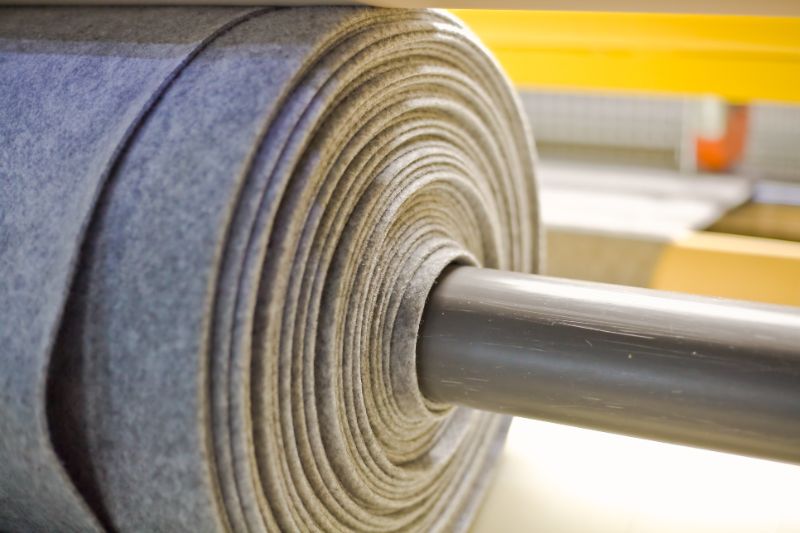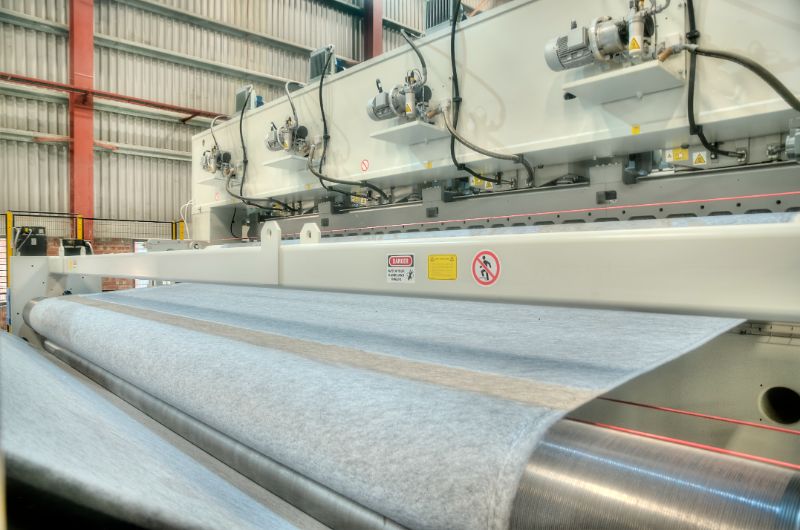Non-woven Geo-textile Fabric
Non-woven geotextile fabrics are permeable geosynthetics constructed of nonwoven materials that are employed as a crucial component of civil engineering projects along with geotechnical material (soil, rock, etc.). It can be created mechanically, chemically, or by heating individual fibers to build a stable fiber network. Nonwoven geotextile fabric is usually built of synthetic polymers from materials like polyester, polypropylene, polyethylene, and polyamide. Because of its strength, low specific gravity, low cost, and dominance in the geotextile industry. However, nonwoven geotextiles consisting of natural fibers are also used (jute, sisal, coir, etc).

What is Non-Woven Geotextile Fabric

Over the past century, geotextile usage has increased consistently. The first geotextiles were made from widely accessible textiles that were already on the market, like carpet backing and upholstery fabric. Manufacturers have altered geotextiles to offer improved advantages for building roads.
The term “geotextile” (which literally translates to “earth protector”) refers to both woven and non-woven textiles constructed of the polymers polypropylene (P.P.) and polyester (PES/PET).
Although non-woven geotextile fabrics have lower tensile strengths than woven types, it is important to remember that they nevertheless possess the same strength, durability, and drainage qualities as their woven counterparts. Nonwoven geotextile fabric is a felt-like material created by thermally fusing polypropylene or a blend of polyester and polypropylene fibers, and then creating it using various techniques including calendaring and needle drilling.
Synthetic textile is used to create nonwoven geotextiles. However, the interlocking of the threads gives them a more erratic structure. Confusion occurs from the comparable applications of wovens and nonwovens. The physical characteristics of woven and nonwoven geotextile fabrics can be used to differentiate them. Nonwoven geotextiles have the familiar “fuzzy” appearance of felt and have a similar look and feel.
Today, a wide variety of techniques are employed while producing nonwoven geotextile fabric. Needle-punching is the most typical industrial process. A vast quantity of tiny fiber fibers are taken and interlocked together using a barbed needle to create needle-punched nonwoven geotextiles. When utilized in a civil application, nonwoven geotextiles typically serve the tasks of separation, filtration, and drainage.
While the woven fabric disintegrates over time when used for underground paths or for rivers, this type of geotextile fabric is easier to cut, has a high water permeability, and is resistant to liquids without deteriorating over time. Given these characteristics, it may be concluded that non-woven geotextiles are most suited for usage in storm drainage systems, underpasses, and other locations where the earth needs long-term stabilization and filtration.
Nonwoven or nonwoven geotextiles are made by fusing materials together using needle punching, chemicals, heat, or other techniques. These geotextiles are made of continuous end filaments or short, strip-shaped fibers that are distributed erratically in lattice layers. Short strip fibers are frequently 1 to 4 inches long. BJ Geo Textiles produces the best quality non-woven geo textiles.
What is needle punched non woven geotextile
Needle punched non woven geotextile fabric is a permeable fabric used with rock, soil, and other geotechnical materials. It is made of non woven materials.
Permeable materials are those that permit the passage of gases and liquids.
Needle punched non woven geotextile fabric is typically produced using the needle-punched or heat bonding process. The needle punched non woven geotextile is made using substances like polyester, polypropylene, polyamide, and others.
Jute, coil, sisal, and other natural fibers are also used in the production of some non-woven geotextiles. Jute-based geotextile is completely biodegradable. It is typically used for seed germination and is referred to as a “jute seed pad.”
The majority of needle punched non woven geotextile fabric, however, are created from polypropylene fiber because of its great strength, low price, and low specific gravity.
These materials are utilized in civil engineering projects. They are either mechanically or chemically generated.
When a machine punches numerous needles onto the web directly, this is known as needle punching. The web becomes flexible and develops pores as a result. These pores improve the fabric’s breathability while also enabling optimum drainage and filtration.
The cloth being used will have a big impact on the different needle punching techniques.
BJ Geo Textiles produces the best quality needle punched non-woven geo textiles.
- In civil engineering, non-woven needle-punched fabric is frequently used for filtration, separation, and reinforcement during construction. They drain better because they are porous.
- The non-woven needle-punched cloth is also simpler to handle because it comes in roll shape.
- The material's lightweight nature does not impair the material's strength or toughness. In comparison to woven geotextiles, it also moves and bends more freely. For separation, non-woven fabric is therefore strongly advised.
- Non-woven needle-punched fabric is impervious to tearing. Since it is sufficiently thick, it is ideal for covering and cushioning geomembranes in locations where there are dams, embankments, landfills, mines, and river canals.
- The non-woven needle-punched cloth has very small pores despite having an excellent drainage system. This implies that it can filter even the smallest particles while allowing water to flow unhindered. It is strongly advised for concrete and asphalt streets in part because of this.
- As a barrier against water intrusion, the cloth performs admirably.
- Non-woven needle-punched cloth has the advantage of being resistant to rapid temperature changes.
- This sturdy material is suitable for demanding changes to the environment and will not submit to strain. Despite being a lightweight material, it is resistant to regular wear and tear because of this.
- There has been an increase in demand for non-woven fabric as a result of the abrupt surge in infrastructural development.
- The majority of the time, the non-woven needle-punched geotextile maker is forced to labor around the clock to meet the fabric's rising demand.
- Because of its exceptional flexibility, the non-woven needle-punched fabric is ideally suited for a variety of technical projects.
- The material is used professionally for tasks like building sports fields, dams, and river canals. They are also utilized in airfields, drainage, water conservation, railway tracks, and highways and roads.
Specifications of Non Woven Geotextile Fabric
Below are the specifications of how we produce our non woven geotextile fabric
- Color: White, Gray
- Weight: 100 gsm – 1000 gsm
- Thickness at 2kPa: 0.92 mm – 9 mm
- Length: upto 100 meter (max)
- Width: upto 5.3 meter (max)
Specifications of Non Woven Geotextile Fabric
- Color: White, Gray
- Weight: 100 gsm – 1000 gsm
- Thickness at 2kPa: 0.92 mm – 9 mm
- Length: upto 100 meter (max)
- Width: upto 5.3 meter (max)
Uses of Non-Woven Geotextile Fabric

Nonwoven geotextile fabric are made from either staple or continuous threads. For roads and railways off-shore land reclamation, road side, rail side, river and canal banks and embarkments, continuous filaments and staple fibers are used for separation, reinforcements, filtration, drainage, moisture barrier, etc. Geotextiles made of non-woven materials can perform a variety of special tasks, including as filtration, drainage, separation, strengthening, and erosion control.
Drainage
Geotextiles are used to transfer liquid or gaseous constituents passively. The geotextile alone performs the drainage tasks. However, it is frequently integrated with additional components like drainage cores and perforated pipes. To improve drainage capacity, needle-punched geotextiles are utilized in combination with other materials. Drainage geo-composites are the name given to this combination.
Separation
Two soil layers with differing particle size distributions are separated using nonwovens. It aids in avoiding the pumping up of fine-grained subgrade soils into permeable granular road bases. It stops a structure’s two neighboring layers from blending together. To guarantee the structure’s long-term performance, nonwoven separator is required.
Reinforcement
Geotextile is used in reinforcing to boost the ability of soft soils to support more weight. One frequent application in the realm of road engineering is reinforcement. The foundation soil’s level of stress can be decreased using nonwovens. because vertical loads can mobilize horizontal shear strains. By dispersing the load over a vast area, nonwoven fabrics help to lessen its intensity.
Filtration
To hold on to tiny soil particles, nonwoven materials are utilized. This method stops small particles from draining away and leaching. It was created in the middle of the 1960s and is most likely the method used in geotextiles most frequently.
Liquid barrier:
The nonwoven geotextiles’ open structure enables it to be saturated with clay particles, which fill the spaces inside the geotextile’s structure and prevent liquids from passing through.
Controlling erosion
Nonwoven materials serve as both a drainage layer and a separator. However, when its primary purpose is to help reduce erosion, it is given a unique classification. The market for nonwoven geotextiles is substantially larger and includes soil erosion management.
FAQ
Before constructing embankments, roads, pipelines, and earth-retaining structures, geotextiles are frequently employed to improve the soil’s properties. Filtration, drainage, strengthening, cushioning, waterproofing, and separation are just a few of the uses for geotextiles.
Nonwovens can be extremely durable or have a short lifespan for one application. Nonwoven materials serve a variety of purposes, including sterility, bacterial barriers, resiliency, stretch, softness, strength, flame retardancy, washability, cushioning, and liquid repellency.
An eco-friendly material with great waterproof and anti-seepage properties is geotextile fabric.
Nevertheless, different treatments and mixing can extend its longevity to up to 20 years.
The strength of the fabric is normally 80-90 lbs grab tensile strength and above that are suitable for a hardscape installation beneath interlock and retaining wall projects, in addition to other landscape drainage projects. There are many different types of non-woven geotextiles available.

